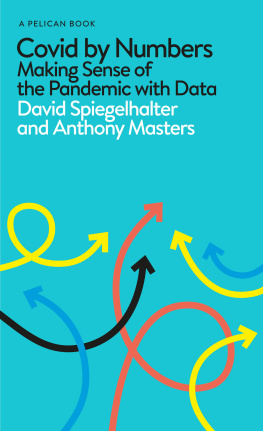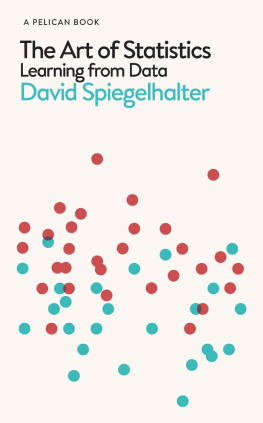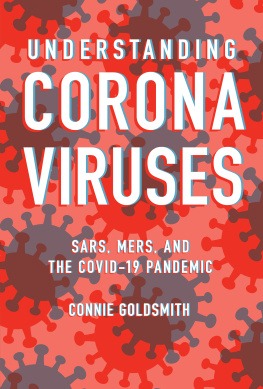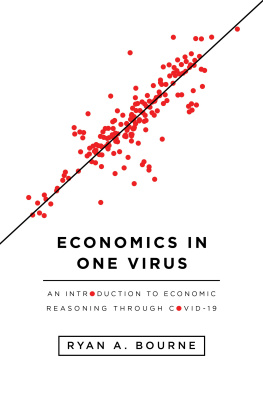Footnotes
Chapter 1: Introduction
, the year group containing the highest number of people) was 53, although all years from 47 to 54 are close contenders.
For each day, this plots the average (mean) of the counts on the day, the three days before it and the three days after it.
The term exponential simply means that the numbers are increasing or decreasing by a fixed proportion in a fixed period. Exponential growth does not have to be rapid: compound interest of 0.1% per year, as currently available in some savings accounts, still provides exponential (if slow) growth.
Chapter 2: How did the pandemic develop?
Viruses have a genome often composed of a strand of ribonucleic acid (RNA) encased in an envelope of proteins, and coronaviruses are distinguished by their crown-like surfaces. They are hardly rare; before 2020 there were six known coronaviruses that could infect humans, four of which cause mild to moderate disease, including common colds. The other two are much more severe: Severe Acute Respiratory Syndrome (SARS) was identified in 2002, and Middle East Respiratory Syndrome (MERS) in 2012.
On 3 March Boris Johnson announced that he had shaken hands with everybody after visiting a ward of Covid-19 patients. Coincidentally, on the same day DS was on BBCs Newsnight, and, along with the other guests, did not shake hands with the staff.
For 23 March 2020, the London School of Hygiene and Tropical Medicine model estimated about 71,000 new infections (with an interval of 26,000145,000). The Imperial College London model estimated around 364,000 new infections (338,000400,000).
To add insult to injury, Liverpool lost 32; 42 on aggregate.
Chapter 3: How infectious is SARS-CoV-2?
A single replication cycle can produce 1,000 virus particles, so in the right circumstances the virus effectively doubles every hour, since 210 is about 1,000. So, in principle, it could multiply over a millionfold each day and a trillionfold in two days this is an extraordinary example of exponential growth.
On 20 March 2020 the WHO claimed that Covid was NOT airborne, and that Current evidence suggests that the main way the virus spreads is by respiratory droplets among people who are in close contact with each other. This was only changed more than a year later, on 30 April 2021. The UK governments Hands, Face, Space mantra was eventually changed to Hands, Face, Space, Fresh Air at the end of March 2021.
The Centers for Disease Control and Prevention (CDC) reports there were 30 confirmed and 22 probable infections with symptomatic Covid-19 from a single symptomatic case. Three people were hospitalized, and two died.
Scientific Pandemic Influenza Group on Modelling, Operational sub-group.
Chapter 4: What is the risk from new variants?
It is unclear what people in Kent called it.
A genome an organisms genetic material is like an instruction manual, written in a special code of four nucleotide base letters. Human DNA is about 3 billion base letters long. In contrast, SARS-CoV-2 has a short RNA strand of around 30,000 letters. Researchers can read these letters in a process called sequencing.
Standard testing involves detecting certain genes, generally the three ORF1ab, N, and S, representing different parts of the coronavirus, and a positive test finds at least one of these genes, excluding the spike protein (S-gene) on its own. The Alpha (B.1.1.7) variant has deletions in the spike protein at positions 69 and 70, which causes standard tests to fail to detect the S-gene, and so spike-gene target failure (SGTF) can be used as a proxy measure for the new variant.
Media reports used the phrase double mutant to describe the B.1.617 lineages. That phrase is meant to refer to two mutations in the spike protein (E484Q and L452R). Since viruses have lots of mutations, the term does not have a specific meaning.
of the Delta (B.1617.2) variants secondary attack rate was 12.5%14.6%. It reflects uncertainty in the central estimate.
Chapter 5: How good are diagnostic tests?
Higher evidence: two or three genes detected, irrespective of Ct value. Moderate evidence: single gene detection if the Ct value was less than 34 or if there was a higher pre-test probability of infection (any symptoms at or around the test, or reporting working in a patient-facing health-care role or resident-facing care-home role). Lower evidence: all other positive tests, which were therefore all in asymptomatic individuals not having a patient-facing or resident-facing role with a single gene detected with a Ct value of 34 or higher.
, which shows that the underlying prevalence of the condition is vital in interpreting the results of the test.
Chapter 6: How many cases have been found?
The European Centre for Disease Control (ECDC) allows for three levels of confidence about cases: possible shows consistent symptoms; probable indicates symptoms after a confirmed contact or which meet diagnostic imaging criteria: confirmed is a positive laboratory test result.
President Magufuli died in March 2021.
These combine counts from testing in Pillar 1 (those with clinical need and health and social workers), Pillar 2 (general public) and Pillar 4 (research purposes). Pillar 3 are antibody tests.
Chapter 7: How many people have been infected with SARS-CoV-2?
Participants received at least 25 in vouchers for each swab. By the end of January 2021, 116,000 vouchers worth 3.8 million had not been redeemed and had subsequently expired.
Participants in previous ONS surveys were originally invited. The acceptance rate dropped to 16% when additionally sampling random addresses.
This involves around 150,000 participants each month taking swab tests to determine prevalence at a single point in time, without follow-up.
Out of 213 paramedics and ambulance staff sampled, 25 tested positive over these four months, which gives a 95% uncertainty interval of 8%17%, well above the average. The uncertainty interval for 0 out of 93 outdoor workers is 0%5%. In general, error margins for individual occupations are wide, making definitive ranking unreliable. These positivity rates were not adjusted for other risk factors.
This figure used an unweighted estimate from the weekly midpoint. Incidence estimates changed to Bayesian modelling later, leading to some incomparability with earlier estimates.
(the proportion infected) was 19% (19%20%). This model estimate is subject to revision.
Chapter 8: How ill do people get with Covid-19?
As the writer and broadcaster Timandra Harkness has said: Why should you never call a statistician average? Because its mean.
Chapter 9: What happened in hospitals?
In England and Scotland, a Covid-19 admission is counted if the person tested positive in the previous 14 days. Northern Ireland counts confirmed Covid-19 admissions with a specific method of admission codes. Unlike the other nations, Wales also includes suspected patients with Covid-19 in their overall count. For patients who get a positive test while in hospital, the admission date is the day before diagnosis.
Between 1 August 2020 and 31 March 2020, NHS England reported around 282,000 Covid-19 admissions and 57,000 Covid-19 hospital deaths within 28 days of a positive test.
Chapter 10: How good are the treatments for Covid-19?
Kahns explanation was incorrect, claiming that of 100 people ill with Covid-19, 35 fewer would die if they received convalescent plasma. That would be remarkable, given that fewer than 35 would be expected to die anyway. What he should have said was that, of 100











